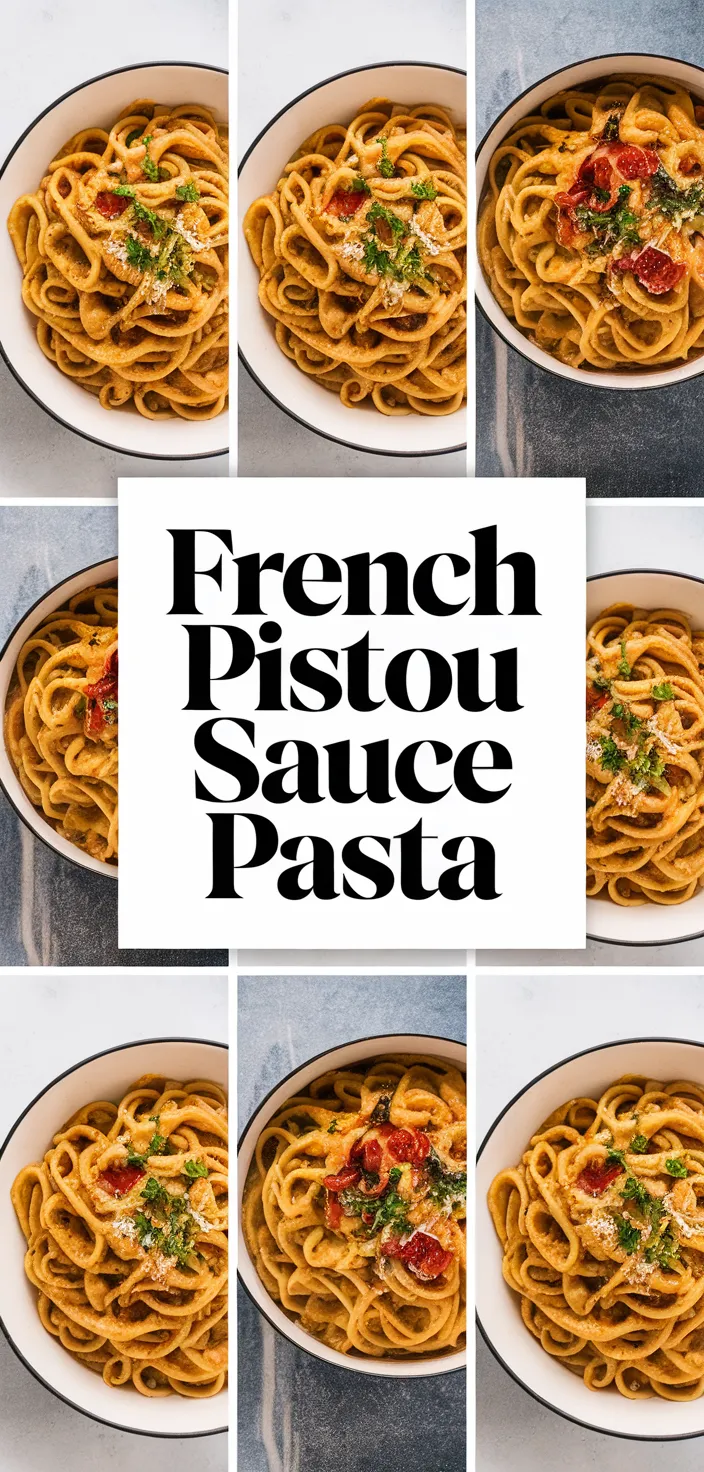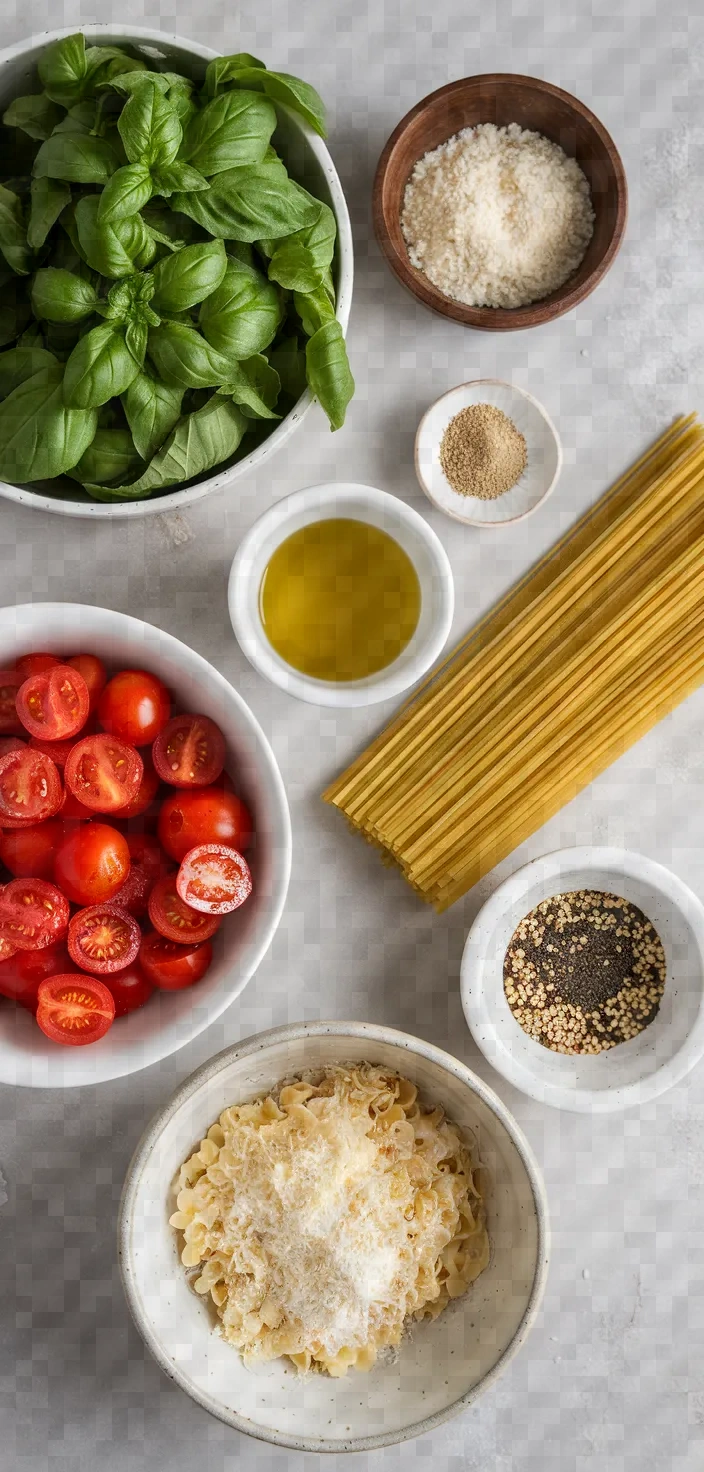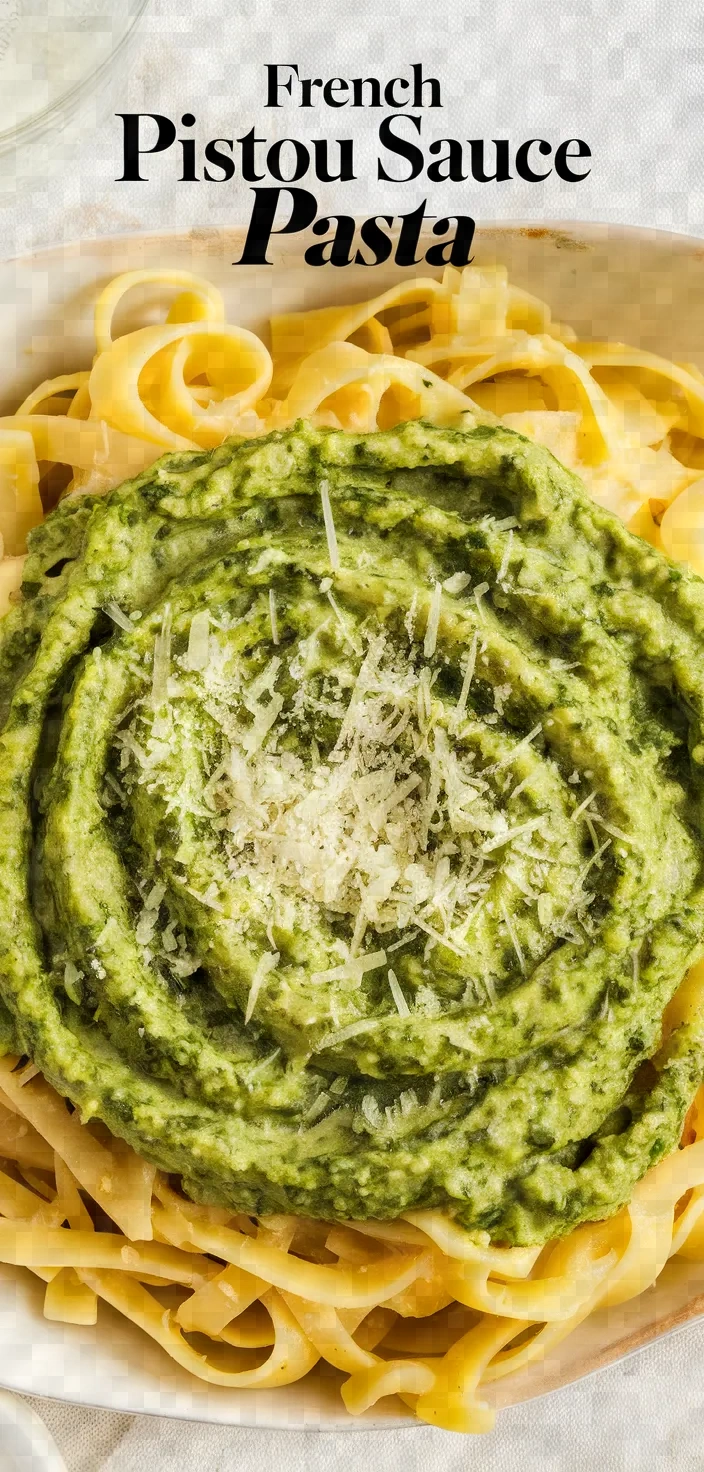I absolutely love this recipe because it perfectly marries the fresh, vibrant flavors of basil and cherry tomatoes with the comforting embrace of perfectly cooked pasta. Plus, the simplicity of the pistou allows the natural ingredients to shine, making every bite a delightful, guilt-free indulgence that’s both satisfying and insta-worthy.

I adore making a French Pistou Sauce Pasta. If you’ve never had pistou, it’s similar to pesto but doesn’t contain nuts.
This sauce is vibrant and healthy—it has 1 cup of made-with-love basil, 1/4 cup of nutty Parmesan, and 1/3 cup of fruity extra virgin olive oil as its base. I tossed it with 1 pound of perfectly al dente pasta and 1/2 cup of halved cherry tomatoes.
Nutty and creamy, with a strong basil flavor, boosted by the firm tomatoes, I could have eaten this alongside a beat-up copy of Mistral for eternally pulsating summer days.
Ingredients

Fresh basil leaves:
Loaded with antioxidants and a zesty, herby taste, adding them to dishes will enhance not only their health benefits but their flavor, too.
Garlic:
Has in it allicin, which is well-known for its anti-inflammatory properties.
Parmesan cheese:
Delivers a taste of umami, along with a wealth of protein and calcium.
Extra virgin olive oil:
Full of monounsaturated fats, heart-healthy.
Cherry tomatoes:
It is rich in vitamins A and C, and also provides sweetness and acidity.
Pine nuts:
A source of protein and essential fats, it offers a nutty crunch.
Ingredient Quantities
- 1 cup fresh basil leaves, packed
- 2 cloves garlic, minced
- 1/4 cup Parmesan cheese, grated
- 1/3 cup extra virgin olive oil
- Salt to taste
- 1 pound pasta of choice (e.g., spaghetti, linguine)
- 1/2 cup cherry tomatoes, halved
- 1/4 cup pine nuts, toasted (optional)
- Freshly ground black pepper to taste
- Grated Parmesan cheese for serving (optional)
Instructions
1. Start by taking a large pot and filling it with water. Make sure it’s enough to cover the pasta completely; otherwise, it will cook unevenly. Easy rule of thumb: use 1 quart of water for every 85 grams (3 ounces) of pasta. Since this recipe calls for 454 grams (1 pound) of pasta, fill a 6-quart pot about two-thirds full.
2. Pistou sauce is prepared while the pasta is cooking. It is made in a food processor by combining these ingredients: 1) fresh basil leaves; 2) minced garlic; 3) grated Parmesan cheese; and 4) a pinch of salt.
3. The mixture should be pulsed a few times until the components are coarsely chopped.
4. With the processor running, gradually drizzle in the extra virgin olive oil until the blend is smooth and well integrated. Taste and adjust the salt as necessary.
5. Prior to draining the pasta, keep back roughly 1 cup of the water in which the pasta cooked.
6. Return the pot or a large mixing bowl to the pasta after draining it.
7. Pasta, along with sauce, is the perfect vehicle for combining flavors and textures. To make a cherry tomato and pistou pasta dish, you first make pistou. It’s similar to pesto but uses fewer nuts, in this case, none at all. When sauce and pasta meet in the dish, they become one, and we have an opportunity to play with what happens inside the bowl.
8. If you are using them, sprinkle the toasted pine nuts over the pasta for added texture and flavor.
9. Add freshly ground black pepper to your personal taste.
10. Serve the pasta right away, with extra grated Parmesan cheese, if you like. And enjoy your meal!
Equipment Needed
1. Large pot (6-quart capacity)
2. Food processor
3. Measuring cups
4. Measuring spoons
5. Chef’s knife
6. Cutting board
7. Colander
8. Large mixing bowl (optional)
9. Wooden spoon or pasta tongs
FAQ
- Can I use dried basil instead of fresh basil leaves?To achieve the authentic flavor of pistou sauce, there’s no substitute for fresh basil. You can use dried basil if you want, but you won’t get the same taste or texture that makes pistou so special.
- What type of pasta works best with pistou sauce?Although any type of pasta can suffice, the long, thin shapes of spaghetti or linguine are the traditional vehicles for this sauce. Both allow the sauce to coat well and, when twirled on a fork, to deliver the essential contents of a seafood dish in every bite.
- Is there a substitute for Parmesan cheese in this recipe?Pecorino Romano can be used as a substitute, but its flavor is stronger. Choose either based on your taste preference.
- Can I omit the pine nuts from the recipe?Certainly! Pine nuts are not mandatory and mainly give a nutty taste and feel. If you need to leave them out, you can without any problem.
- How should I store leftover pistou sauce?Keep any leftover pistou in an airtight container in the refrigerator, where it will stay fresh for up to 3 days. To prevent the top layer from browning, drizzle a little olive oil on top of the pistou before sealing the container.
- Can I make the pistou sauce in advance?Pistou sauce can be prepared ahead of time. Just keep it in the refrigerator and give it a good stir before using it.
Substitutions and Variations
In addition to or instead of basil leaves, fresh mint can be used in the same quantities for a unique flavor twist.
You can substitute vegan Parmesan for Parmesan cheese in a recipe calling for it if you’re using a nutritional yeast or a similar product in a dairy-free recipe.
You can use avocado oil instead of extra virgin olive oil.
If you’re out of pine nuts, walnuts, or almonds work well for a nutty texture.
Instead of using cherry tomatoes, sun-dried tomatoes can be employed in their stead, and for a more intense tomato flavor, add more sun-dried tomatoes.
Pro Tips
1. Use Pasta Water Before draining the cooked pasta, reserve about a cup of the pasta water. Use this starchy water to help emulsify the pistou sauce with the pasta, making it silkier and helping the sauce cling better to the noodles.
2. Toast Pine Nuts Carefully If you’re using pine nuts, toast them gently in a dry pan over low heat until they are golden brown. Toasting enhances their flavor, but be careful as they can burn quickly.
3. Chop Basil Precisely When making the pistou, pulse the basil leaves gently in the food processor to avoid bruising them too much, which can lead to a bitter taste. Just a few pulses should be enough to coarsely chop them.
4. Freshness Matters Use the freshest basil and garlic you can find for the best flavor in your pistou sauce. Fresh ingredients will elevate the overall taste of the dish significantly.
5. Rest the Sauce After blending the pistou, let it sit for a few minutes. This allows the flavors to meld and develop, resulting in a more cohesive and flavorful sauce.

French Pistou Sauce Pasta Recipe
My favorite French Pistou Sauce Pasta Recipe
Equipment Needed:
1. Large pot (6-quart capacity)
2. Food processor
3. Measuring cups
4. Measuring spoons
5. Chef’s knife
6. Cutting board
7. Colander
8. Large mixing bowl (optional)
9. Wooden spoon or pasta tongs
Ingredients:
- 1 cup fresh basil leaves, packed
- 2 cloves garlic, minced
- 1/4 cup Parmesan cheese, grated
- 1/3 cup extra virgin olive oil
- Salt to taste
- 1 pound pasta of choice (e.g., spaghetti, linguine)
- 1/2 cup cherry tomatoes, halved
- 1/4 cup pine nuts, toasted (optional)
- Freshly ground black pepper to taste
- Grated Parmesan cheese for serving (optional)
Instructions:
1. Start by taking a large pot and filling it with water. Make sure it’s enough to cover the pasta completely; otherwise, it will cook unevenly. Easy rule of thumb: use 1 quart of water for every 85 grams (3 ounces) of pasta. Since this recipe calls for 454 grams (1 pound) of pasta, fill a 6-quart pot about two-thirds full.
2. Pistou sauce is prepared while the pasta is cooking. It is made in a food processor by combining these ingredients: 1) fresh basil leaves; 2) minced garlic; 3) grated Parmesan cheese; and 4) a pinch of salt.
3. The mixture should be pulsed a few times until the components are coarsely chopped.
4. With the processor running, gradually drizzle in the extra virgin olive oil until the blend is smooth and well integrated. Taste and adjust the salt as necessary.
5. Prior to draining the pasta, keep back roughly 1 cup of the water in which the pasta cooked.
6. Return the pot or a large mixing bowl to the pasta after draining it.
7. Pasta, along with sauce, is the perfect vehicle for combining flavors and textures. To make a cherry tomato and pistou pasta dish, you first make pistou. It’s similar to pesto but uses fewer nuts, in this case, none at all. When sauce and pasta meet in the dish, they become one, and we have an opportunity to play with what happens inside the bowl.
8. If you are using them, sprinkle the toasted pine nuts over the pasta for added texture and flavor.
9. Add freshly ground black pepper to your personal taste.
10. Serve the pasta right away, with extra grated Parmesan cheese, if you like. And enjoy your meal!
